Catherine of Aragon
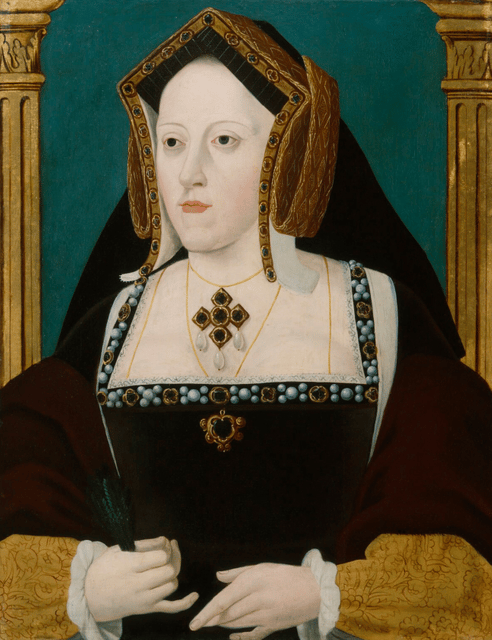
Catherine of Aragon

| Catherine of Aragon | |
|---|---|
| Queen consort of England | |
| Tenure | 11 June 1509 – 23 May 1533 |
| Coronation | 24 June 1509 |
| Born | 16 December 1485 Archiepiscopal Palace of Alcalá de Henares, Alcalá de Henares, Castile |
| Died | 7 January 1536(1536-01-07)(aged 50) Kimbolton Castle, England |
| Burial | 29 January 1536 Peterborough Cathedral, Peterborough, England |
| Spouse |
|
| Issue among others... |
|
| House | Trastámara |
| Father | Ferdinand II of Aragon |
| Mother | Isabella I of Castile |
| Religion | Roman Catholicism |
| Signature | |
Catherine of Aragon (Spanish: Catalina; 16 December 1485 – 7 January 1536) was Queen of England from June 1509 until May 1533 as the first wife of King Henry VIII; she was previously Princess of Wales as the wife of Henry's elder brother, Arthur.
The daughter of Isabella I of Castile and Ferdinand II of Aragon, Catherine was three years old when she was betrothed to Arthur, Prince of Wales, heir apparent to the English throne. They married in 1501, but Arthur died five months later. She held the position of ambassador of the Aragonese Crown to England in 1507, the first female ambassador in European history.[5] Catherine subsequently married Arthur's younger brother, the recently ascended Henry VIII, in 1509. For six months in 1513, she served as regent of England while Henry VIII was in France. During that time the English won the Battle of Flodden, an event in which Catherine played an important part with an emotional speech about English courage.[6]
By 1525, Henry VIII was infatuated with Anne Boleyn and dissatisfied that his marriage to Catherine had produced no surviving sons, leaving their daughter, the future Mary I of England, as heir presumptive at a time when there was no established precedent for a woman on the throne. He sought to have their marriage annulled, setting in motion a chain of events that led to England's schism with the Catholic Church. When Pope Clement VII refused to annul the marriage, Henry defied him by assuming supremacy over religious matters. In 1533 their marriage was consequently declared invalid and Henry married Anne on the judgement of clergy in England, without reference to the Pope. Catherine refused to accept Henry as Supreme Head of the Church in England and considered herself the King's rightful wife and queen, attracting much popular sympathy.[7] Despite this, she was acknowledged only as Dowager Princess of Wales by Henry. After being banished from court by Henry, she lived out the remainder of her life at Kimbolton Castle, and died there on 7 January 1536 of cancer. English people held Catherine in high esteem, and her death set off tremendous mourning.[8]
The controversial book The Education of a Christian Woman by Juan Luis Vives, which claimed women have the right to an education, was commissioned by and dedicated to her in 1523. Such was Catherine's impression on people that even her enemy, Thomas Cromwell, said of her, "If not for her sex, she could have defied all the heroes of History."[9] She successfully appealed for the lives of the rebels involved in the Evil May Day, for the sake of their families.[10] Catherine also won widespread admiration by starting an extensive programme for the relief of the poor.[11][10] She was a patron of Renaissance humanism, and a friend of the great scholars Erasmus of Rotterdam and Thomas More.[11]
| Catherine of Aragon | |
|---|---|
| Queen consort of England | |
| Tenure | 11 June 1509 – 23 May 1533 |
| Coronation | 24 June 1509 |
| Born | 16 December 1485 Archiepiscopal Palace of Alcalá de Henares, Alcalá de Henares, Castile |
| Died | 7 January 1536(1536-01-07)(aged 50) Kimbolton Castle, England |
| Burial | 29 January 1536 Peterborough Cathedral, Peterborough, England |
| Spouse |
|
| Issue among others... |
|
| House | Trastámara |
| Father | Ferdinand II of Aragon |
| Mother | Isabella I of Castile |
| Religion | Roman Catholicism |
| Signature | |
Early life
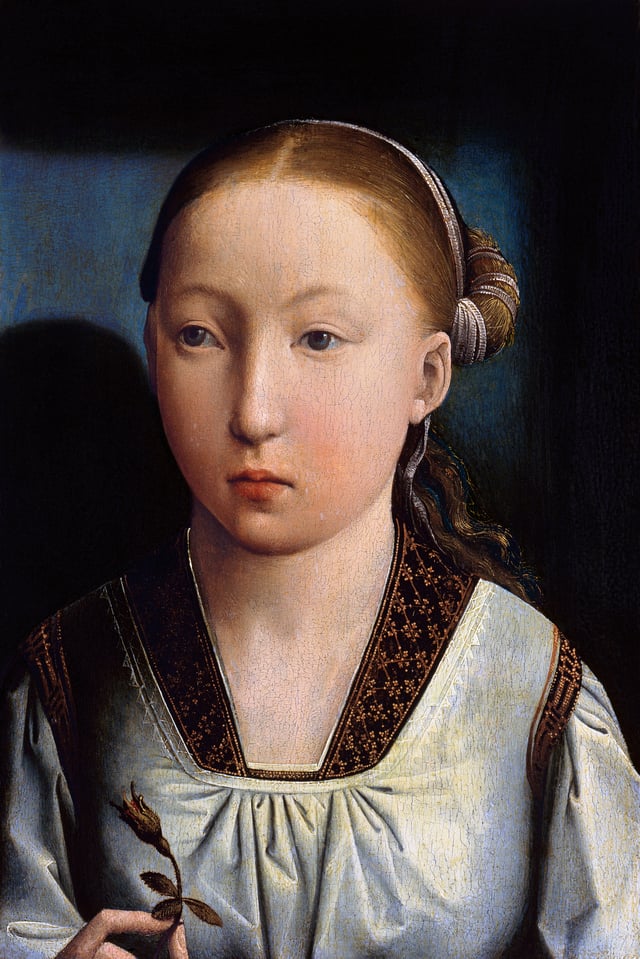
Portrait by Juan de Flandes thought to be of 11-year-old Catherine. She resembles her sister Joanna of Castile.
Catherine was born at the Archbishop's Palace of Alcalá de Henares near Madrid, on the night of 16 December 1485. She was the youngest surviving child of King Ferdinand II of Aragon and Queen Isabella I of Castile.[12] Catherine was quite short in stature[13] with long red hair, wide blue eyes, a round face, and a fair complexion.[14] She was descended, on her maternal side, from the English royal house; her great-grandmother Catherine of Lancaster, after whom she was named, and her great-great-grandmother Philippa of Lancaster were both daughters of John of Gaunt and granddaughters of Edward III of England. Consequently, she was third cousin of her father-in-law, Henry VII of England,[15] and fourth cousin of her mother-in-law Elizabeth of York.
Catherine was educated by a tutor, Alessandro Geraldini, who was a clerk in Holy Orders. She studied arithmetic, canon and civil law, classical literature, genealogy and heraldry, history, philosophy, religion, and theology. She had a strong religious upbringing and developed her Roman Catholic faith that would play a major role in later life.[16] She learned to speak, read and write in Spanish and Latin, and spoke French and Greek. She was also taught domestic skills, such as cooking, dancing, drawing, embroidery, good manners, lace-making, music, needlepoint, sewing, spinning, and weaving.[17] Scholar Erasmus later said that Catherine "loved good literature which she had studied with success since childhood".[18]
At an early age, Catherine was considered a suitable wife for Arthur, Prince of Wales, heir apparent to the English throne, due to the English ancestry she inherited from her mother. By means of her mother, Catherine had a stronger legitimate claim to the English throne than King Henry VII himself through the first two wives of John of Gaunt, 1st Duke of Lancaster: Blanche of Lancaster and Constance of Castile. In contrast, Henry VII was the descendant of Gaunt's third marriage to Katherine Swynford, whose children were born out of wedlock and only legitimised after the death of Constance and the marriage of John to Katherine. The children of John and Katherine, while legitimised, were barred from inheriting the English throne, a stricture that was ignored in later generations. Because of Henry's descent through illegitimate children barred from succession to the English throne, the Tudor monarchy was not accepted by all European kingdoms. At the time, the House of Trastámara was the most prestigious in Europe,[15] due to the rule of the Catholic Monarchs, so the alliance of Catherine and Arthur validated the House of Tudor in the eyes of European royalty and strengthened the Tudor claim to the English throne via Catherine of Aragon's ancestry. It would have given a male heir an indisputable claim to the throne. The two were married by proxy on 19 May 1499 and corresponded in Latin until Arthur turned fifteen, when it was decided that they were old enough to be married.[19]
Catherine was accompanied to England by the ambassadors Diego Fernández de Córdoba y Mendoza, 3rd Count of Cabra, Alonso de Fonseca, archbishop of Santiago de Compostela, and Antonio de Rojas Manrique, bishop of Mallorca.[20] She brought a group of her African attendants with her, including one identified as the trumpeter John Blanke.[21] They are the first Africans recorded to have arrived in London at the time, and were considered luxury servants. They caused a great impression about the princess and the power of her family.[22] Her Spanish retinue was supervised by her duenna, Elvira Manuel.
As wife and widow of Arthur
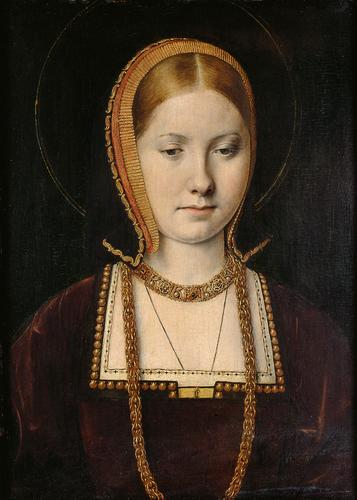
Portrait of a noblewoman, possibly Mary Tudor c. 1514 or Catherine of Aragon c. 1502, by Michael Sittow. Kunsthistorisches Museum, Vienna.[23]
Then-15-year-old Catherine met Arthur on 4 November 1501 at Dogmersfield in Hampshire.[24][25][26] Little is known about their first impressions of each other, but Arthur did write to his parents-in-law that he would be "a true and loving husband" and told his parents that he was immensely happy to "behold the face of his lovely bride". The couple had corresponded in Latin, but found that they could not understand each other's spoken conversation, because they had learned different Latin pronunciations.[27] Ten days later, on 14 November 1501, they were married at Old St. Paul's Cathedral.[15] A dowry of 200,000 ducats had been agreed, and half was paid shortly after the marriage.[28]
Once married, Arthur was sent to Ludlow Castle on the borders of Wales to preside over the Council of Wales and the Marches, as was his duty as Prince of Wales, and his bride accompanied him. The couple stayed at Castle Lodge, Ludlow. A few months later, they both became ill, possibly with the sweating sickness, which was sweeping the area. Arthur died on 2 April 1502; 16-year-old Catherine recovered to find herself a widow.[29]
At this point, Henry VII faced the challenge of avoiding the obligation to return her 200,000 ducat dowry, half of which he had not yet received, to her father, as required by her marriage contract should she return home.[30] Following the death of Queen Elizabeth in February 1503, King Henry VII initially considered marrying Catherine himself, but the opposition of her father and potential questions over the legitimacy of the couple's issue ended the idea.[31] To settle the matter, it was agreed that Catherine would marry Henry VII's second son, Henry, Duke of York, who was five years younger than she was. The death of Catherine's mother, however, meant that her "value" in the marriage market decreased. Castile was a much larger kingdom than Aragon, and it was inherited by Catherine's elder sister, Joanna. Ostensibly, the marriage was delayed until Henry was old enough, but Ferdinand II procrastinated so much over payment of the remainder of Catherine's dowry that it became doubtful that the marriage would take place. She lived as a virtual prisoner at Durham House in London.[32] Some of the letters she wrote to her father complaining of her treatment have survived. In one of these letters she tells him that "I choose what I believe, and say nothing. For I am not as simple as I may seem." She had little money and struggled to cope, as she had to support her ladies-in-waiting as well as herself. In 1507 she served as the Spanish ambassador to England, the first female ambassador in European history.[5] While Henry VII and his councillors expected her to be easily manipulated, Catherine went on to prove them wrong.[5]
Marriage to Arthur's brother depended on the Pope granting a dispensation because canon law forbade a man to marry his brother's widow (Lev. 18:16[1]). Catherine testified that her marriage to Arthur was never consummated as, also according to canon law, a marriage was not valid until consummated.[33][34]
Queenship
Wedding
Catherine's second wedding took place on 11 June 1509,[35] seven years after Prince Arthur's death. She married Henry VIII, who had only just acceded to the throne, in a private ceremony in the church of the Observant Friars outside Greenwich Palace. She was 23 years of age.[35][36]
Coronation
On Saturday 23 June 1509, the traditional eve-of-coronation procession to Westminster was greeted by a large and enthusiastic crowd. As was the custom, the couple spent the night before their coronation at the Tower of London. On Midsummer's Day, Sunday, 24 June 1509, Henry VIII and Catherine were anointed and crowned together by the Archbishop of Canterbury at a lavish ceremony at Westminster Abbey. The coronation was followed by a banquet in Westminster Hall. Many new Knights of the Bath were created in honour of the coronation.[35] In that month that followed, many social occasions presented the new Queen to the English public. She made a fine impression and was well received by the people of England.[29]
Pregnancies and children
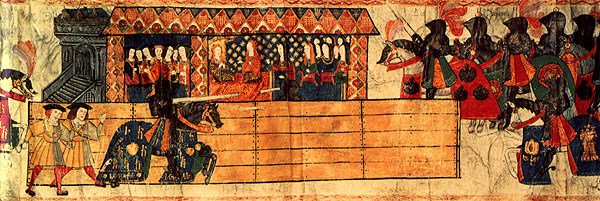
Catherine watching Henry jousting in her honour after giving birth to a son. Henry's horse mantle is emblazoned with Catherine's initial letter, 'K.'
In August 1509, two months after the wedding, Catherine's first pregnancy was announced. On 31 January 1510, she miscarried a girl.
In May 1510, four months after the loss of her first child, Catherine announced her second pregnancy. A son, Henry, Duke of Cornwall, was born on 1 January 1511. In his honour, guns were fired from the Tower of London and the city bells were rung, beacons were lit and free wine was distributed to all the population. Five days after his birth, on 6 January 1511, the prince was christened at Richmond Palace, his godparents being the Archbishop of Canterbury, the Earl of Surrey and the Countess of Devon. On 22 February 1511, after only 52 days of life, the young prince died suddenly. It was said that he died of an intestinal complaint.
By early 1513, Catherine was pregnant again.[39] On 30 June 1513, Catherine was left as regent in England when Henry VIII went to fight in France. On 17 September 1513, she went into labour prematurely and gave birth to a boy who was either stillborn or died shortly after birth.
In June 1514, Catherine announced her fourth pregnancy. On 8 January 1515, she gave birth to a stillborn boy.
In the summer of 1515, Catherine announced her fifth pregnancy; however, less hope was placed on an heir following her previous failed pregnancies. On 18 February 1516, Catherine delivered a healthy girl at 4 a.m. at Greenwich Palace, Kent.[40] She was named Mary and christened three days later (21 February) with great ceremony at the Church of Observant Friars. Despite his evident disappointment, Henry VIII said that if it were a girl this time then surely boys would follow.
In 1517, Catherine suffered another miscarriage.
In February 1518, Catherine announced her seventh pregnancy. In March, she visited Merton College, Oxford, and also made a pilgrimage to the shrine of St Frideswide, asking for a healthy son. On 10 November 1518 she gave birth to a daughter, but the child was weak and lived only a few hours.
Influence

Portrait of Henry VIII by Hans Holbein the Younger circa 1540
On 11 June 1513, Henry appointed Catherine Regent in England with the titles "Governor of the Realm and Captain General," while he went to France on a military campaign.[41] When Louis d'Orléans, Duke of Longueville, was captured at Thérouanne, Henry sent him to stay in Catherine's household. She wrote to Wolsey that she and her council would prefer the Duke to stay in the Tower of London as the Scots were "so busy as they now be" and she added her prayers for "God to sende us as good lukke against the Scotts, as the King hath ther."[42] The war with Scotland occupied her subjects, and she was "horrible busy with making standards, banners, and badges" at Richmond Palace. The Scots invaded and on 3 September 1513, she ordered Thomas Lovell to raise an army in the midland counties.[43]
Catherine rode north in full armour to address the troops, despite being heavily pregnant at the time. Her fine speech was reported to the historian Peter Martyr d'Anghiera in Valladolid within a fortnight.[44] Although an Italian newsletter said she was 100 miles (160 km) north of London when news of the victory at Battle of Flodden Field reached her, she was near Buckingham.[45] From Woburn Abbey she sent a letter to Henry along with a piece of the bloodied coat of King James IV of Scotland, who died in the battle, for Henry to use as a banner at the siege of Tournai.[46]
Catherine's religious dedication increased as she became older, as did her interest in academics. She continued to broaden her knowledge and provide training for her daughter, Mary. Education among women became fashionable, partly because of Catherine's influence, and she donated large sums of money to several colleges. Henry, however, still considered a male heir essential. The Tudor dynasty was new, and its legitimacy might still be tested.[47] A long civil war (1135–54) had been fought the last time a woman (Empress Matilda) had inherited the throne. The disasters of civil war were still fresh in living memory from the Wars of the Roses.[48]
In 1520, Catherine's nephew, the Holy Roman Emperor Charles V,[49] paid a state visit to England, and she urged Henry to enter an alliance with Charles rather than with France. Immediately after his departure, she accompanied Henry to France on the celebrated visit to Francis I, the Field of the Cloth of Gold. Within two years, war was declared against France and the Emperor was once again welcome in England, where plans were afoot to betroth him to Catherine's daughter Mary.
The King's great matter
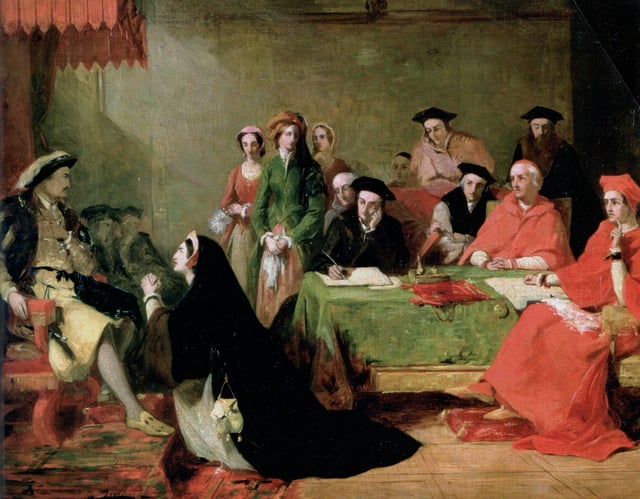
The Trial of Queen Catherine of Aragon, by Henry Nelson O'Neil (1846–48, Birmingham Museums)
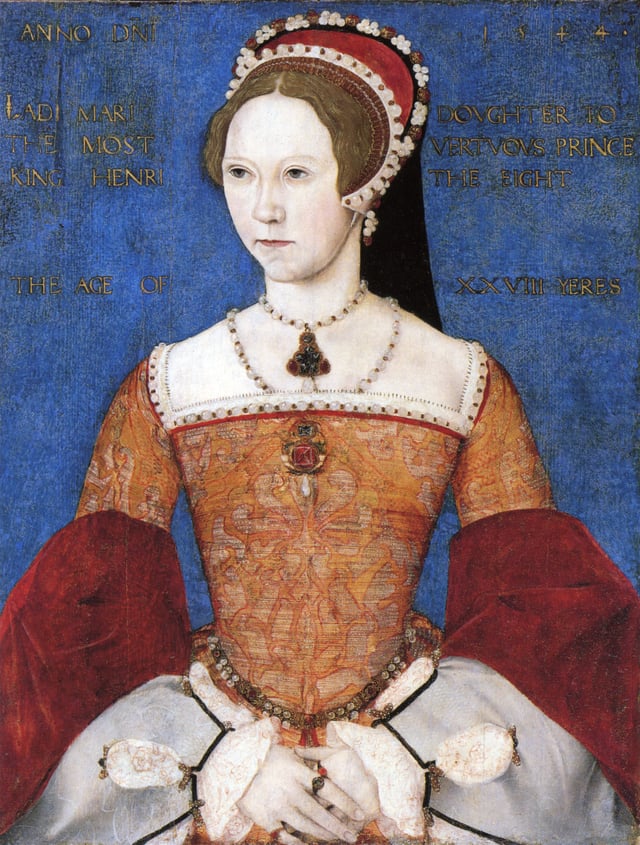
Catherine and Henry's daughter The Lady Mary
In 1525, Henry VIII became enamoured of Anne Boleyn, a lady-in-waiting to Queen Catherine; Anne was 11 years younger than Henry. Henry began pursuing her;[50] Catherine was no longer able to bear children by this time. Henry began to believe that his marriage was cursed and sought confirmation from the Bible, which he interpreted to say that if a man marries his brother's wife, the couple will be childless.[51][11] Even if her marriage to Arthur had not been consummated (and Catherine would insist to her dying day that she had come to Henry's bed a virgin), Henry's interpretation of that biblical passage meant that their marriage had been wrong in the eyes of God.[34] Whether the Pope at the time of Henry and Catherine's marriage had the right to overrule Henry's claimed scriptural impediment would become a hot topic in Henry's campaign to wrest an annulment from the present Pope.[34] It is possible that the idea of annulment had been suggested to Henry much earlier than this, and is highly probable that it was motivated by his desire for a son. Before Henry's father ascended the throne, England was beset by civil warfare over rival claims to the English crown, and Henry may have wanted to avoid a similar uncertainty over the succession.[52]
It soon became the one absorbing object of Henry's desires to secure an annulment.[53] Catherine was defiant when it was suggested that she quietly retire to a nunnery, saying: "God never called me to a nunnery. I am the King's true and legitimate wife".[54] He set his hopes upon an appeal to the Holy See, acting independently of Cardinal Thomas Wolsey, whom he told nothing of his plans. William Knight, the King's secretary, was sent to Pope Clement VII to sue for an annulment, on the grounds that the dispensing bull of Pope Julius II was obtained by false pretenses.
As the Pope was, at that time, the prisoner of Catherine's nephew, Emperor Charles V, following the Sack of Rome in May 1527, Knight had difficulty in obtaining access to him. In the end, Henry's envoy had to return without accomplishing much. Henry now had no choice but to put this great matter into the hands of Wolsey, who did all he could to secure a decision in Henry's favour.[55]
Wolsey went so far as to convene an ecclesiastical court in England with a representative of the Pope presiding, and Henry and Catherine herself in attendance. The Pope had no intention of allowing a decision to be reached in England, and his legate was recalled. (How far the pope was influenced by Charles V is difficult to say, but it is clear Henry saw that the Pope was unlikely to annul his marriage to the Emperor's aunt.[56]) The Pope forbade Henry to marry again before a decision was given in Rome. Wolsey had failed and was dismissed from public office in 1529. Wolsey then began a secret plot to have Anne Boleyn forced into exile and began communicating with the Pope to that end. When this was discovered, Henry ordered Wolsey's arrest and, had he not been terminally ill and died in 1530, he might have been executed for treason.[57] A year later, Catherine was banished from court, and her old rooms were given to Anne Boleyn. Catherine wrote in a letter to Charles V in 1531:
My tribulations are so great, my life so disturbed by the plans daily invented to further the King's wicked intention, the surprises which the King gives me, with certain persons of his council, are so mortal, and my treatment is what God knows, that it is enough to shorten ten lives, much more mine.[58][59]
When Archbishop of Canterbury William Warham died, the Boleyn family's chaplain, Thomas Cranmer, was appointed to the vacant position.[60]
When Henry decided to annul his marriage to Catherine, John Fisher became her most trusted counsellor and one of her chief supporters. He appeared in the legates' court on her behalf, where he shocked people with the directness of his language, and by declaring that, like John the Baptist, he was ready to die on behalf of the indissolubility of marriage. Henry was so enraged by this that he wrote a long Latin address to the legates in answer to Fisher's speech. Fisher's copy of this still exists, with his manuscript annotations in the margin which show how little he feared Henry's anger. The removal of the cause to Rome ended Fisher's role in the matter, but Henry never forgave him.[61][62] Other people who supported Catherine's case included Thomas More; Henry's own sister Mary Tudor, Queen of France (though as a member of the Tudor family and of royal blood, she was safe from any punishment and execution); María de Salinas; Holy Roman Emperor Charles V; Pope Paul III; and Protestant Reformers Martin Luther[63] and William Tyndale.[64]
Banishment and death
Upon returning to Dover from a meeting with King Francis I of France in Calais, Henry married Anne Boleyn in a secret ceremony.[65] Some sources speculate that Anne was already pregnant at the time (and Henry did not want to risk a son being born illegitimate) but others testify that Anne (who had seen her sister Mary Boleyn taken up as the king's mistress and summarily cast aside) refused to sleep with Henry until they were married. Henry defended the legality of their union by pointing out that Catherine had previously been married. If she and Arthur had consummated their marriage, Henry by canon law had the right to remarry.[66] On 23 May 1533, Cranmer, sitting in judgement at a special court convened at Dunstable Priory to rule on the validity of Henry's marriage to Catherine, declared the marriage illegal, even though Catherine testified she and Arthur had never had physical relations. Cranmer ruled Henry and Anne's marriage valid five days later, on 28 May 1533.[67]
Until the end of her life, Catherine would refer to herself as Henry's only lawful wedded wife and England's only rightful queen, and her servants continued to address her by that title. Henry refused her the right to any title but "Dowager Princess of Wales" in recognition of her position as his brother's widow.[65]
Catherine went to live at The More castle in the winter of 1531/32.[68] In 1535 she was transferred to Kimbolton Castle. There, she confined herself to one room (which she left only to attend Mass), dressed only in the hair shirt of the Order of St. Francis, and fasted continuously. While she was permitted to receive occasional visitors, she was forbidden to see her daughter Mary. They were also forbidden to communicate in writing, but sympathizers discreetly ferried letters between the two. Henry offered both mother and daughter better quarters and permission to see each other if they would acknowledge Anne Boleyn as the new queen. Both refused.[68]
In late December 1535, sensing her death was near, Catherine made her will, and wrote to her nephew, the Emperor Charles V, asking him to protect her daughter. It has been alleged that she then penned one final letter to Henry, her "most dear lord and husband":[69]
My most dear lord, king and husband, The hour of my death now drawing on, the tender love I owe you forceth me, my case being such, to commend myself to you, and to put you in remembrance with a few words of the health and safeguard of your soul which you ought to prefer before all worldly matters, and before the care and pampering of your body, for the which you have cast me into many calamities and yourself into many troubles. For my part, I pardon you everything, and I wish to devoutly pray God that He will pardon you also. For the rest, I commend unto you our daughter Mary, beseeching you to be a good father unto her, as I have heretofore desired. I entreat you also, on behalf of my maids, to give them marriage portions, which is not much, they being but three. For all my other servants I solicit the wages due them, and a year more, lest they be unprovided for. Lastly, I make this vow, that mine eyes desire you above all things. Katharine the Quene.
The authenticity of the letter itself has been questioned, but not Catherine's attitude in its wording, which has been reported with variations in different sources.[70]
Catherine died at Kimbolton Castle on 7 January 1536.[71] The following day, news of her death reached the king. At the time there were rumours that she was poisoned,[72][73][74] possibly by Gregory di Casale.[75] According to the chronicler Edward Hall, Anne Boleyn wore yellow for the mourning, which has been interpreted in various ways; Polydore Vergil interpreted this to mean that Anne did not mourn.[76] Chapuys reported that it was King Henry who decked himself in yellow, celebrating the news and making a great show of his and Anne's daughter, Elizabeth, to his courtiers.[77] This was seen as distasteful and vulgar by many. Another theory is that the dressing in yellow was out of respect for Catherine as yellow was said to be the Spanish colour of mourning. Certainly, later in the day it is reported that Henry and Anne both individually and privately wept for her death. On the day of Catherine's funeral, Anne Boleyn miscarried a boy. Rumours then circulated that Catherine had been poisoned by Anne or Henry, or both, as Anne had threatened to murder both Catherine and Mary on several occasions. The rumours were born after the apparent discovery during her embalming that there was a black growth on her heart that might have been caused by poisoning.[78] Modern medical experts are in agreement that her heart's discolouration was due not to poisoning, but to cancer, something which was not understood at the time.[79]
Catherine was buried in Peterborough Cathedral with the ceremony due to her position as a Dowager Princess of Wales, and not a queen. Henry did not attend the funeral and forbade Mary to attend.[79]
Faith
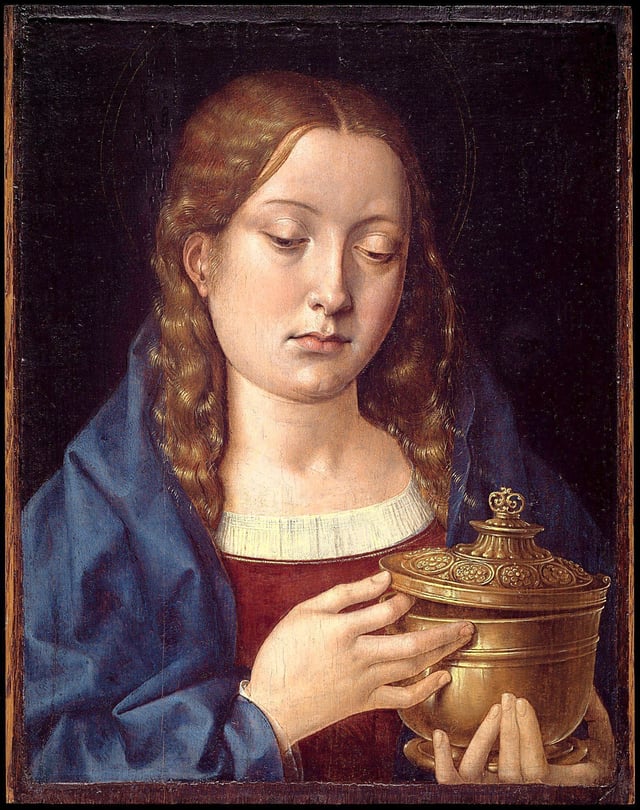
Michael Sittow, Mary Magdalene, probably using Catherine as model
Catherine was a member of the Third Order of Saint Francis and she was punctilious in her religious obligations in the Order, integrating without demur her necessary duties as queen with her personal piety. After her divorce, she was quoted "I would rather be a poor beggar’s wife and be sure of heaven, than queen of all the world and stand in doubt thereof by reason of my own consent."[80]
The outward celebration of saints and holy relics formed no major part of her personal devotions,[81] which she rather expressed in the Mass, prayer, confession and penance. Privately, however, she was aware of what she identified as the shortcomings of the papacy and church officialdom.[81] Her doubts about Church improprieties certainly did not extend so far as to support the allegations of corruption made public by Martin Luther in Wittenberg in 1517, which were soon to have such far-reaching consequences in initiating the Protestant Reformation.
In 1523 Alfonso de Villa Sancta, a learned friar of the Observant (reform) branch of the Friars Minor and friend of the king's old advisor Erasmus, dedicated to the queen his book De Liberio Arbitrio adversus Melanchthonem denouncing Philip Melanchthon, a supporter of Luther. Acting as her confessor, he was able to nominate her for the title of "Defender of the Faith" for denying Luther's arguments.[82]
Appearance
Catherine was of a very fair complexion, had blue eyes, and had a hair colour that was between reddish-blonde and auburn.[83] In her youth she was described as "the most beautiful creature in the world"[84] and that there was "nothing lacking in her that the most beautiful girl should have".[13] Thomas More and Lord Herbert would reflect later in her lifetime that in regard to her appearance "there were few women who could compete with the Queen [Catherine] in her prime."[85][86]
Legacy, memory, and historiography
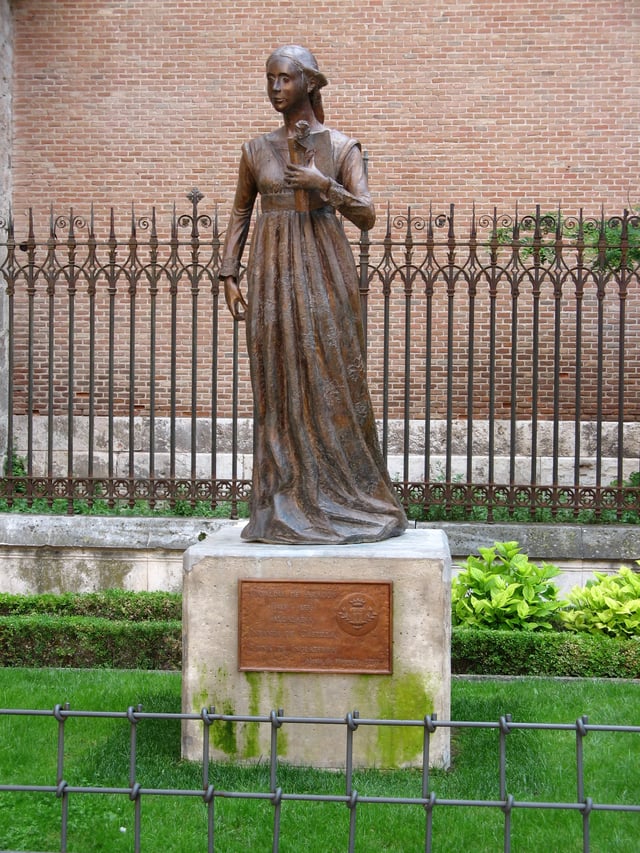
Statue of Catherine at Alcalá de Henares
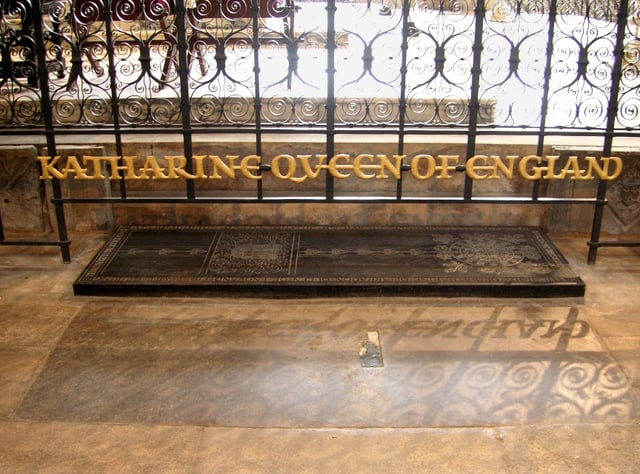
Grave of Catherine of Aragon in Peterborough Cathedral
The controversial book "The Education of Christian Women" by Juan Luis Vives, which claimed women have the right to an education, was dedicated to and commissioned by her. Such was Catherine's impression on people, that even her enemy, Thomas Cromwell, said of her "If not for her sex, she could have defied all the heroes of History."[9] She successfully appealed for the lives of the rebels involved in the Evil May Day for the sake of their families.[10] Furthermore, Catherine won widespread admiration by starting an extensive programme for the relief of the poor.[10] She was also a patron of Renaissance humanism, and a friend of the great scholars Erasmus of Rotterdam and Saint Thomas More. Some saw her as a martyr.[87][88]
In the reign of her daughter Mary I of England, her marriage to Henry VIII was declared "good and valid". Her daughter Queen Mary also had several portraits commissioned of Catherine, and it would not by any means be the last time she was painted. After her death, numerous portraits were painted of her, particularly of her speech at the Legatine Trial, a moment accurately rendered in Shakespeare's play about Henry VIII.
Her tomb in Peterborough Cathedral[89] can be seen and there is hardly ever a time when it is not decorated with flowers or pomegranates, her heraldic symbol. It bears the title Katharine Queen of England.
In the 20th century, George V's wife, Mary of Teck, had her grave upgraded and there are now banners there denoting Catherine as a Queen of England. Every year at Peterborough Cathedral there is a service in her memory. There are processions, prayers, and various events in the Cathedral including processions to Catherine's grave in which candles, pomegranates, flowers and other offerings are placed on her grave. On the service commemorating the 470th anniversary of her death, the Spanish Ambassador to the United Kingdom attended. During the 2010 service a rendition of Catherine of Aragon's speech before the Legatine court was read by Jane Lapotaire. There is a statue of her in her birthplace of Alcalá de Henares, as a young woman holding a book and a rose.[90]
Catherine has remained a popular biographical subject to the present day. The American historian Garrett Mattingly was the author of a popular biography Katherine of Aragon in 1942. In 1966, Catherine and her many supporters at court were the subjects of Catherine of Aragon and her Friends, a biography by John E. Paul. In 1967, Mary M. Luke wrote the first book of her Tudor trilogy, Catherine the Queen which portrayed her and the controversial era of English history through which she lived.
In recent years, the historian Alison Weir covered her life extensively in her biography The Six Wives of Henry VIII, first published in 1991. Antonia Fraser did the same in her own 1992 biography of the same title; as did the British historian David Starkey in his 2003 book Six Wives: The Queens of Henry VIII.[91][92][93] Giles Tremlett's biography Catherine of Aragon: The Spanish Queen of Henry VIII came out in 2010, and Julia Fox's 2011 dual biography Sister Queens: The Noble, Tragic Lives of Katherine of Aragon and Juana, Queen of Castile.
Places and statues
In Alcalá de Henares, the place of Catherine's birth, a statue of Catherine as a young woman holding a rose and a book can be seen in the Archbishop's Palace.
Peterborough is twinned with the Spanish city of Alcalá de Henares, located in the wider Community of Madrid. Children from schools in the two places have learned about each other as part of the twinning venture, and artists have even come over from Alcalá de Henares to paint Catherine's tombstone.
Many places in Ampthill are named after Catherine. Also in Ampthill there is a cross in Ampthill Great Park named "Queen Catherine's Cross" in her honour. It is on the site of the castle where she was sent during her divorce from the King.
Kimbolton School's science and mathematics block is called the QKB, or Queen Katherine Building.
Spelling of her name
Her baptismal name was "Catalina", but "Katherine" was soon the accepted form in England after her marriage to Arthur.[81] Catherine herself signed her name "Katherine", "Katherina", "Katharine" and sometimes "Katharina". In a letter to her, Arthur, her husband, addressed her as "Princess Katerine". Her daughter Queen Mary I called her "Quene Kateryn", in her will. Rarely were names, particularly first names, written in an exact manner during the sixteenth century and it is evident from Catherine's own letters that she endorsed different variations.[2] Loveknots built into his various palaces by her husband, Henry VIII, display the initials "H & K",[3] as do other items belonging to Henry and Catherine, including gold goblets, a gold salt cellar, basins of gold, and candlesticks. Her tomb in Peterborough Cathedral is marked "Katharine Queen of England".[94][95]
In art and media
Over the years, numerous artistic and cultural works have been dedicated to Catherine, have been written about her, or have mentioned her, including some by her husband Henry VIII, who wrote "Grene growth the holy"[97] about and for her, and Juan Luis Vives, who dedicated The Education of Christian Women to her.[98]
Catherine of Aragon has been portrayed in film, television, plays, novels, songs, poems, and other creative forms many times, and as a result she has stayed very much in popular memory. The first episode of The Six Wives of Henry VIII, is told from her point of view (and in which she is portrayed by Annette Crosbie). Charlotte Hope plays her in the STARZ mini-series The Spanish Princess, which is based on the book The Constant Princess by Philippa Gregory. William Shakespeare's play Henry VIII succeeds in recreating with great accuracy Catherine's statement about the legitimacy of her marriage at the court in Blackfriars before King Henry, and Shakespeare's portrayal of Catherine is remarkably sympathetic; however, most of the rest of the play is an attempt to absolve many, especially Henry VIII, and the timing of key incidents (including Catherine's death) is changed and other events are avoided (the play makes Henry nearly an innocent pawn in the hands of a dastardly Cardinal Wolsey, and the play stops short of Anne Boleyn's execution).
In January 2013, the National Portrait Gallery in London revealed that its curators had recently discovered that a portrait at Lambeth Palace formerly believed to have been a portrait of Catherine Parr in fact shows Catherine of Aragon. The National Portrait Gallery announced that the painting, which had hung in a private sitting room of the Archbishop of Canterbury since at least the 19th century, would be paired with a portrait of Henry VIII already in the museum's collection, and would remain at the museum on loan.[99]
Music and rhymes
Books
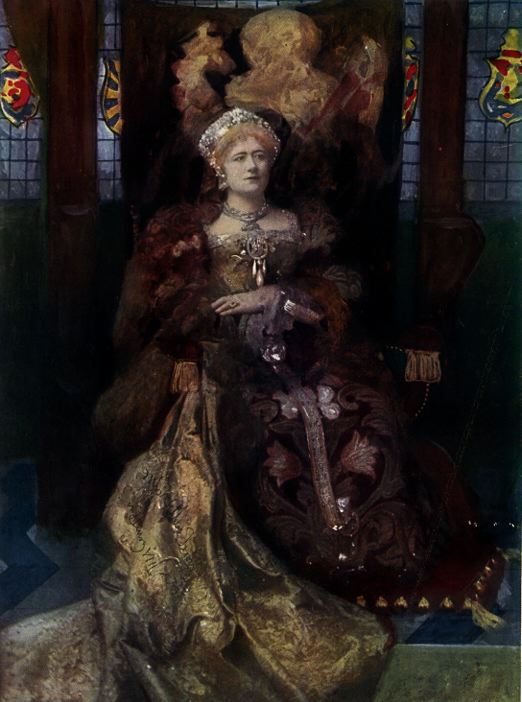
Dame Ellen Terry as Catherine of Aragon
Catherine is the main character in:
Katharine, The Virgin Widow, The Shadow of the Pomegranate, and The King's Secret Matter (later published in an omnibus Katharine of Aragon) by Jean Plaidy[103]
My Catalina by Maureen Peters
The King's Pleasure by Norah Lofts[104]
The Constant Princess by Philippa Gregory (a novel about Catherine's younger years)[105]
Patience, Princess Catherine by Carolyn Meyer (young adult novel)[106]
Isabella's Daughter by Charity Bishop
Catherine of Aragon/My Tudor Queen by Alison Prince
Katherine of Aragon, The True Queen by Alison Weir[107]
Falling Pomegranate Seeds: The Duty of Daughters (The Katherine of Aragon Story Book 1) by Wendy J. Dunn[108]
Catherine of Aragon: An Intimate History of Henry VIII's True Wife by Amy Licence[109]
Catherine is a character in:
Murder Most Royal by Jean Plaidy
The Trusted Servant by Alison Macleod
The Other Boleyn Girl, The King's Curse and Three Sisters, Three Queens by Philippa Gregory[110]
The Dark Rose, Volume 2 of The Morland Dynasty, by Cynthia Harrod-Eagles
Wolf Hall by Hilary Mantel[111]
I, Elizabeth by Rosalind Miles[112]
Keeper of the King's Secrets by Michelle Diener[113]
Theatre, film, stage, and TV
Catherine was portrayed by:
Sarah Siddons in the 18th century, in Shakespeare's Henry VIII. She told Samuel Johnson that the role of Queen Catherine was her favourite of all the Shakespearean roles she had played, as it was "the most natural".[114]
Violet Vanbrugh in the 1911 short film production of William Shakespeare's play Henry VIII (first film portrayal).[115]
German actress Hedwig Pauly-Winterstein in the 1920 film Anna Boleyn.[116]
Rosalie Crutchley in The Sword and the Rose, an account of Mary Tudor's romance with the Duke of Suffolk in 1515.[117]
Greek actress Irene Papas in Hal B. Wallis' film Anne of the Thousand Days (1969).[118]
British actress Annette Crosbie in a 90-minute television drama titled "Catherine of Aragon", the first part of the BBC series The Six Wives of Henry VIII, for which she won the 1971 BAFTA TV Award for Best Actress.[119]
Frances Cuka in the 1972 film Henry VIII and His Six Wives, based on the above TV series.[120] Keith Michell reprised his role as Henry VIII. A scene was incorporated between Frances Cuka and Charlotte Rampling (playing Anne Boleyn) to show their quiet, glacial enmity.
Annabelle Dowler in Dr. David Starkey's 2001 documentary series The Six Wives of Henry VIII.[121]
Spanish actress Yolanda Vasquez, a brief appearance in the British TV version of The Other Boleyn Girl (January 2003), opposite Jared Harris as Henry VIII and Natascha McElhone as Mary Boleyn.[122]
Assumpta Serna in the October 2003 ITV two-part television drama Henry VIII, which starred Ray Winstone in the title role.[123] Part 1 chronicled the king's life from the birth of his bastard son, Henry Fitzroy until the execution of Anne Boleyn in 1536. David Suchet co-starred as Cardinal Wolsey.
Marge Simpson (voiced by Julie Kavner), as "Margerine of Aragon" in The Simpsons episode "Margical History Tour".[124]
Maria Doyle Kennedy in the Showtime 2007 television series The Tudors opposite Jonathan Rhys Meyers as Henry. For her performance, Kennedy won an IFTA Award for Best Actress in a Supporting Role Television,[125] and a Gemini Award for an Actress in a Featured Supporting Role in a Dramatic Series.[126]
Ana Torrent in the 2008 film adaptation of The Other Boleyn Girl, with Eric Bana as Henry VIII.[127]
Virginia Weeks portrayed her in the play Six Dead Queens and an Inflatable Henry.[128]
In 2008 she was played by Victoria Peiró in the film The Twisted Tale of Bloody Mary.[129]
She is played by Siobhan Hewlett in the 2009 documentary Henry VIII: The Mind of a Tyrant.[130]
Kate Duchêne in a 2010 adaptation of Shakespeare's Henry VIII at Shakespeare's Globe Theatre.[131]
Joanne Whalley in Wolf Hall.[132]
Natalia Rodríguez Arroyo in the Spanish historical series Isabel.[133]
Mélida Molina in the Spanish historical series Carlos, rey emperador.[134]
Paola Bontempi in the BBC One history programme Six Wives with Lucy Worsley.[135]
Jarneia Richard-Noel in the 2017 musical Six, by Toby Marlow and Lucy Moss.[136] It is set for a 2019 West End run.
Charlotte Hope portrays Catherine in the Starz mini-series The Spanish Princess which is based on two novels by Philippa Gregory. The series aired in May 2019.[137]
Ancestry
See also
Descendants of Isabella I of Castile and Ferdinand II of Aragon
List of English consorts